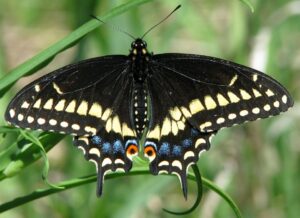Black Swallowtail Butterfly Life Cycle

The eastern black swallowtail butterfly can be found throughout southern Canada, most of the eastern and mid-western United States, west to the Rocky Mountains, southwest into Arizona, and northern Mexico. This butterfly has two generations a year, the first group of butterflies emerges between late April and early June.
After overwintering in the chrysalis, the second generation reproduces for the next generation the following spring. They can be identified by their black wings with light-colored spots on the trailing end.
On the female, the spots are iridescent blue, the underside of the wings have bright spots that are orange. The male has pale green spots.
Their natural habitat includes farmlands, open fields, urban landscapes, meadows, and parks. There are over 550 species of swallowtail butterflies worldwide.
Nectar plants For the black swallowtail butterfly
To attract the black swallowtail to your garden area you need to provide a food source or nectar plants. Some of their food sources are zinnia, phlox, milkweed, butterfly weed, gaillardia, parsley, cosmos, Mexcian sunflower, bee balm, Joe Pye weed, lantanas, sedum, and purple cornflower.
The host plant of the black swallowtail caterpillar
The caterpillar of the black swallowtail also needs a food source, some of these plants included are fennel, dill, Queen, Anne’s lace, caraway, water cowbane, celery, wild parsnip, mock Bishop’s weed, and spotted hemlock.
The caterpillar or larval stage
The female lays up to 200 to 430 eggs, the eggs are pale yellow, what I found interesting is that the eggs are laid at a rate of 30 to 50 per day. Each egg is laid individually on the underside of the caterpillar’s food source (caterpillar’s host plants). Just before hatching which takes 10 t0 13 days, the eggs will turn a dark gray. The caterpillar or larval stage will take anywhere from 3 to 4 weeks.
Chrysalis or pupil stage
After eating for about 2 to 3 weeks and reaching its full length the caterpillar begins to pupate, during this stage they will wrap themselves in silk forming a chrysalis. The chrysalis is safely attached to a tree by a thread, during this stage, a beautiful transformation begins to take place as a butterfly begins to form. During the colder or winter months, they overwinter until spring where they emerge totally transformed.
Adult butterfly stage
Once the adulthood stage is completed which is about 6 to 14 days the butterfly begins to work its way out of the cocoon breaking free where it shows its beauty. This hidden transformation is so amazing, once free the butterfly pumps fluid into its wings this action of pumping fluid into its wings is so it can take to flight. The life span of these butterflies is a mere 2 weeks which is so short for a beautiful creature.
The final word on eastern black swallowtail butterfly
The eastern black swallowtail butterfly is amazing, their colors are stunning, what I love about the presence of butterflies in a garden is how they bring a garden to life with their colors and many activities. So if you are interested in attracting these butterflies then following this guide will help you to have much success as you create a home watching them in their natural habitat.
About the author
Norman loves being in the garden, both at home and for his job....
he is 'Natures Little helper' being outdoors, growing his vegetables and flowers from an early age.
Now having spent over 22 years in the profession he want to give some of his knowledge to others...
his vast array of hints and tips you will find scattered over this site will help you no end growing plants in your garden.

Thanks for this article Norman. I just love butterflies and the Eastern Black Swallowtail looks gorgeous. I’m just sorry that we don’t have them in Australia as I would love to see some of them in our garden. The closest we get is a black with a blue swirl on it and that is super special. I enjoyed reading about the life cycle and it is sad that they only live for two weeks but at least you get two generations in one year. Truly lovely.
Hello, I am so happy that I could help, these butterflies are beautiful and can really make a garden feel like a garden with their presence if you know what I mean. All the best to you and have a good day.
Hi Norman, It is such a delight to watch butterflies as they leisurely flutter about a flowery garden. I’d love to see more of them in my home in the southeastern USA. Thanks for the guide to help me create an environment that will attract them and benefit them. I’ve had great success bringing songbirds and hummingbirds to the yard with bird feeders, but this can hopefully take things to the next level. Thank you so much!
Hello Aly so happy to see you and it is so good to hear that you are attracting some wildlife to your garden. Hopefully you will have good success with butterflies also. Please let me know how it goes and have a greàt day.
Several years ago my granddaughters and I came across two caterpillars on my dill plant. We put them in a medium size terrarium with more dill branches. We checked on them daily and we were lucky enough to watch them emerge into butterflies. It was so amazing to see. They actually walked on the girls’ hands until they were ready to take their first flight. We will never forget witnessing this beautiful act of nature.